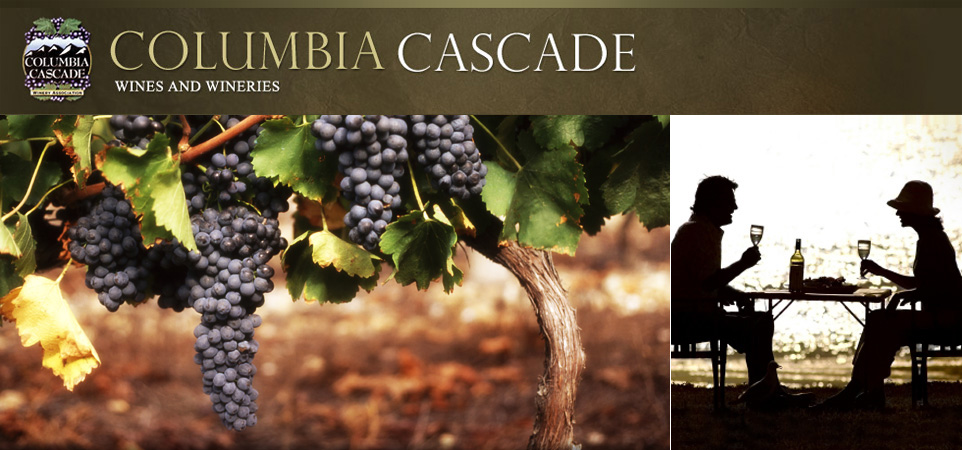Washington State Wine Glossary and Wine Terms
Acidic: or tart, sour. All wines contain some acids, predominantly tartaric. Raw, young wines are generally more acidic than older ones. improperly balanced wines may taste sour because of an abnormally high acid content.
Alcohol: the sine qua non of wine, its affects run from the obvious to the not so obvious. Alcohol doesn’t just provide the kick: it gives texture (“body”), flavor (roundness and sweetness) and vinosity (makes it smell and taste like wine) as well as providing balance and a certain chemical and physical stability to wines. The primary alcohol is known as ethyl alcohol or ethanol, but there are dozens of other so-called “higher” alcohols which though in minute quantities provide hundreds of flavors.
Apples: some German Rieslings, some Chardonnays, and some Chenin blanc wines smell and/or taste of apples as part of their varietal character. Often, an oxidized wine will smell of apples, generally less acidic or over-ripe apples.
Apricots: Sémillons, Muscats (Moscatos), and some sweet Rieslings recall apricots: wines affected by Botrytis cinerea, or noble rot, may often recall apricots or peaches.
Aroma: that portion of the smell of a wine derived specifically from the grape variety, such as Cabernet-Sauvignon or Chardonnay, as opposed to that portion of the smell derived from other sources (see Bouquet).
Austere: the more prestigious châteaux wines of PauiIlac and St. Julien are sometimes referred to thusly. It implies a sensation of pleasant bitterness from tannins. Think of crisp lemonade as opposed to cola or country well water as opposed to soft tap water. Beaujolais, Lietfraumilch, or most American jug wines would not be considered austere.
Balance: a balanced wine is one whose constituents–sugar, acids, tannins, alcohols, etc.–are evident but do not mask one another. A young red wine–tannic and acidic– is not considered balanced because these two characteristics mask the other flavor elements of the wine, which, given time, may display themselves.
Bananas: very young wines–tank samples, wines which have undergone a very cold fermentation or freshly bottled wines–will often smell like bananas. The component responsible for this is iso-amyl acetate, which diminishes with age. Some nouveaux Beaujolais display this in spades.
Berries: berry-like is a nebulous, fruity characteristic of young red wines, notably Zinfandels or Bacos.
Bitter: one of the four basic taste sensations. Young, red Bordeaux or Cabernet-Sauvignons will taste bitter because of their relatively high tannin content. Tannin is a bitter element in wines.
Black currant: Bordeaux wines with a high percentage of Cabernet-Sauvignon, and similarly-based California wines may recall blackcurrant or cassis flavor as do some Syrahs.
Body: English wine authority Michael Broadbent puts it well in his Wine Tasting: “the weight of the wine in the mouth due to its alcoholic content and to its other physicai components. These in turn are due to the quality of the wine, to the vintage, its geographical origin, and general style. Wines from hotter climates tend to have more body than those from the north (compare the Rhône with the Mosel, for example).”
Botrytis cinerea: Latin name for one of many molds which attacks grapes on the vine. Under the proper conditions and at the proper time, this mold will often have a beneficial affect upon the resulting wine’s quality. Grapes affected beneficially by the mold, called noble rot, may smelI more or less like peaches or apricots.
Bouquet: as opposed to aroma, bouquet is more encompassing. It is the odor which derives from the fermentation process, from the aging in wood and bottle process, and other changes independent of the grape variety used.
Breed: according to Michael Broadbent, English wine authority, breed is “a distinctive and distinguished quality stemming from the combination of fine site soil, cépage (grape type), and the skill of the vignernon winemaker)’.
Brilliant: perfectly clear, without haziness. Brilliant wines often have higher than normal acidities.
Brix: a measure of grape solids in a juice sample, usually at picking time. The great majority of these solids are sugars which are fermentable into alcohol. By measuring the brix of grape juice at picking, it is possible to estimate the final alcoholic content of the wine. So when a wine writer asks a winemaker “what was the brix at picking” he is not just trying to be cute.
Bunch: the term to describe a full cluster of grape berries; also used to describe any non-Muscadine grape, most often employed by winegrowers in the American southeast.
Butter(y): often said of Chardonnay-based wines that have undergone a malolactic conversion/fermentation.
Carbonic maceration: a method of fermentation, invented by the Rhône-French in the 1930s involving an intra-cellular transformation within whole berries, as opposed to allowing the berries’ juice to be expressed and fermented normally. Wines–usually red–fermented this way are referred to as “nouveau” or “primeur’.
Character: a wine of good character is one which doesn’t just slip down the throat and say “bye-bye”; it says “stop a while, friend. You have just come upon an above-average liquid. Think on it”.
Cherry (Black Cherry): this fruit on the nose or palate is the hallmark signpoint of Pinot noir; many also claim to find it in wines made from Tempranillo grapes.
Chewy: a high-but-balanced acid wine with a greater than average tannin content is considered chewy. Some Bordeaux reds, especially St. Estèphes, California coastal mountain Cabernets or Shiraz wines are so described.
Chaptalization: is the addition of “foreign” sugars (beet or cane) to a must in order to raise the final alcoholic content of the wine.
Cloves: usually the mark of new French oak.
Cold fermentation: a method of fermenting grape juice into wine at lowered (c. 55 degrees F.) temperatures in order to conserve as much fruit/varietal character as possible.
Complex: a complex wine is many-faceted; it contains not only acids, alcohols, tannins, etc., but more. Each sip brings another flavor, reveals another nuance.
Cross: a breeding of one variety of grape with another to obtain a more desirable offspring. The “noble”
Cabernet-Sauvignon was crossed with the “common” Carignane to arrive at the Ruby Cabernet grape, a cross intended to produce a variety capable of surviving the hot climes of the Central Valley well enough to produce a decent wine.
Crush: in wine lingo, the time of year when the grapes are picked and processed. Grapes for the so-called “finer” wines are not literally and dramatically crushed, but are broken open to allow their juice to run out.
Dry: a dry wine is without noticeable sweetness. Technically, a dry wine retains little or no sugar after fermentation.
Earthy: not actually referring to a dirty or soil-like smell or taste, but to a characteristic of the wine derived from its special soil and climate. The iodine-like quality that many relate to red Graves wines, or the rubbery character many associate with Mayacamas Mountain Cabernets is called earthy, or possessing goût de terroir (taste of the ecosystem, if you will).
Estate-bottled: a term that classically means the grapes for the wine in the bottle were grown by the fellow that bottled the wine (and raised, tended, and picked the grapes, as well).
Fat: generally referring to a wine of higher than average alcohol and/or glycerin content.
Filter: to strain out wine solids by mechanical means, large or small.
Fine: to reduce the solids content of wine after fermentation. In traditional operations, egg whites, or milk solids is used, more often, a fine clay called “bentonite” or the like is used.
Finish: the sensual impression — long or short, strong or weak –that lingers after you have swallowed a wine; a.k.a “aftertaste”.
Flat: usually connoting a wine without acid tang; oxidized.
Flowery: a nebulous term referring to an indeterminate fragrance akin to flowers in general. Mosel wines are flowery, as are some Chenin Blancs, Seyval Blancs, and Aurores.
Fortified: wines having had grape spirit added to them are considered fortified: Sherries, Ports, Madeiras, etc.
Free run: wine that is allowed to flow by gravity from the fermenter. It is considered lighter and less rich than press wine, but is often blended with it to arrive at a balanced product.
Fruity: a pleasant fragrance from ripe grapes made into wine; a berry-like quality akin to fruits in general.
Green: usually said of younger, raw, acidic white or red wine; a rough aspect that usually softens with age; also the appearance of a more acidic than average wine will be green-tinged.
Green bell Peppers: Cabernets (franc and Sauvignon), Sauvignon blancs, Merlots and other varieties are said to produce a green bell pepper character, especially when the grapes are grown in cooler climates or under dense foliage conditions.
Hybrid: grape varieties produced by hybridizers in the lab, usually involving more than one species, are called hybrids. The great Midwestern and Eastern sections of this country are planted to the so-called “French-American” hybrids, vines that are part vinifera and part native American species (aestivalis, labrusca, etc.). They were produced in an effort to arrive at vineplants better-suited to particular climates than pure vinifera; there are also “natural” hybrids, varieties that evolved by a haphazard crossing of two varieties or species.
Late Harvest: a term seen on wine labels to indicate that the grapes for the wine were left on the vine to ripen, often raisin, for longer than normal. Usually a so-labeled wine will be higher than average in residual sugar and/or alcohol.
Legs: a wine’s body or viscosity can be determined, often, by the way rivulets (or sheets, or “tears”) of wine descend the inner glass after swirling. It has to deal with the surface tension and other technical stuff; but a look at the legs will give you tips on the wine’s nature: in a dry wine, slow falling legs indicate a full-bodied-wine; quick-falling indicate a light wine.
Malolactic conversion: a conversion by bacteria of the malic acid in wines into lactic acid which results in a lowering of the overall acidity, and, hence, tartness of the wine. The conversion occurs mainly in wines from cooler climates where there is an excess of malic acidity in the grapes and wine, and usually happens after the alcoholic fermentation. Modern methods, however, allow for malolactic conversions brought about by the addition of malolactic-inducing cultures.
Mellow: a soft, smooth, often sweet-edged wine a “jug red” and a well-aged Cabernet-Sauvignon or Zinfandel may all be mellow.
Must: the term for the mixture of grape juice, skins, seeds, and pulp in a red wine fermentation or just the juice in a white fermentation.
Nouveau: term used to indicate a wine that has been made to capture the ultimate in freshness and fruit character but which seldom has any aging potential. Nouveaux are usually made by carbonic maceration and are usually released for sale earlier than other wines.
Oaky: term used to describe the flavor of wines that have been aged in small, usually newish wood barrels.
Oxidized: all wines are oxidized to a degree because of the presence of oxygen in or near them. A high degree of oxidation is not desirable in most table wines, while in fortified wines, especially Sherries, a greater oxidation is attained and desired. A table wine smelling more like a Sherry and tasting generally lifeless is said to be more or less oxidized.
pH: a measure of the intensity of the acidity (hydrogen ions) in grape juice and wine. pH is often a better measure of acid balance in a juice than is the total acidity. You’ll see the term used in writings about wine, but it is better left in the lab.
Plums: sometimes found in Late Harvest wines of higher than average sugar-at-picking or alcohol contents; also noticed in some Zinfandels, Petite Sirahs, Cabernet-Sauvignons, and older Port(o)s.
Pomace: residue, usually grape skins, un-used pulp, and seeds, after fermentation is completed. Pomace is sometimes plowed back into a field for fertilizer, but is often dumped for fear of contaminating a vineyard with parasites or other vine problems.
Press wine: that portion of the wine that is pressed from the skins, pulp, etc., after draining off the free run wine. It is usually richer in extract, tannins, and other flavoring materials and is often partially blended back into the free run.
Prickly: a taste sensation derived from small amounts of residual carbon dioxide in wines. Often a prickly character can be noticed in white wines fermented cold (the lowering of the temperature tends to integrate more carbon dioxide than usual); its appreciation is relative to the individual taster.
Processed: a term used to describe many jug wines. It connotes, in both smell and taste, a wine that has been put through so many machines, has had so many things added to and/or taken away from it, and has been so manufactured as to appeal to the great bland palate that it is utterly without redeeming social value or character. ‘Cheese food’ is processed; Stilton isn’t.
Proprietary: one of the three ways Americans label their wines (see also Generic and Varietal); usually the bottling or producing winery owns the name so that competing wineries are barred from its use. E.g. Gallo’s “Paisano” or Phelps “Insignia”.
Rack: the process of draining wine from a holding tank in order to separate it from the sediment that has collected at the bottom. This also serves to aerate the wine.
Raisiny: the flavor one senses in wines made from grapes that have more or less dried (shriveled and/or raisined) on the vine; often encountered in hot-climate wines.
Residual sugar: a measure of the sugar left in a wine after the alcoholic fermentation is completed and a key to the sweetness. More and more wineries are listing this on their back or front labels as an aid to the consumer.
Resin: the smell, predominating in Greek Retsinas, caused by the addition of small amounts of resin to the fermentation.tavel rosés and American Grenache-based rosés display a greater or lesser degree of resinous odors, while not actually having had resin added to them.
Solera: a term referring to a method known as “fractional blending” in which older wines are blended with younger wines to arrive at a consistent, similar-tasting product. Authentic Sherries and many other fortified wines are produced using a solera.
Spicy: many wines will display distinct or nebulous (“what is that flavor?”) spicy flavors such as dill, basil, or the like. Often, any tangy character in a wine, such as that in a fairly dry Gewürztraminers, will be described as spicy.
Stemmy: a term applying either to wines actually having been fermented in contact with their stems, or to wines which, owing to an unusually brutal crushing or pressing, contain an excess of the bitter tannins of the stems.
Sulfur dioxide: a chemical which is added to most wines of the world and which is necessary for the stability of any commercial wine. Wine with an excess of SO 2 will smell and/or taste like fresh-struck matches although advances in modern technology have obviated these problems.
Sweet: a basic taste sensation dependent mainly upon grape sugars, but also one resulting from alcohol, new oak and to a degree glycerin,. A sweet, as opposed to a dry wine is one which retains some sugar after fermentation has ended.
Tannin: a natural constituent of wines, especially reds. It is a bitter-tasting material which is partially responsible for preserving wines during their sometimes long aging periods. Bite a grape seed to experience the flavor of tannin.
Teinturier: generic name for any grape whose natural juice is red-colored or pink-colored, (as opposed to most varieties whose juice is colorless). In Spanish, tintorera.
Thin: lacking in body or alcohol; a watery wine.
Topping Up: the practice of completely filling casks or tanks with wine to assure that there is no air space in the container.
Ullage: the distance between the cork and the wine as the bottle stands upright. A large ullage in an older wine is normal; a similar level in a younger wine might mean trouble.
Varietal: term used to describe wines made totally or predominantly from a single variety of grape.
Velvety: akin to mellow, but more so, without the connotation of sweetness. Someone once said that a velvety wine is “one that coats your tongue like a robe’.
Volatile: most of the flavor components of wines are volatile, or easily perceivable by the nose. Volatile acidity refers to the acetic acid and ethyl acetate content of wines, their vinegary aspect.
Wood(y): many wines are aged or treated in wood containers, ranging in size from fifty to one million gallons. In well-made, well-aged wines this wood lends a characteristic smell and taste–depending upon the type of wood used and the size of the barrel–which is just another facet of the wine. Old wood, contaminated wood, or excessive wood aging will result in an overly woody, sometimes astringent smell and taste.
Yeasty: yeasts, or rather enzymes in yeasts, ferment wines. Some maintain that yeasts in fino Sherry butts (casks) contribute to the yeasty flavor of these wines. Others see the yeasty character of Champagnes to be directly related to the long period of yeast contact that such wines have. However, what we perceive as yeast-smells in Champagne (or similarly made sparkling wines from other countries) is more likely the result of a lightly to strongly oxidized white-grape wine blend, Chardonnay in Champagne’s case. Experiment with fresh Chardonnay-rich Champagnes (or “Blanc de Blancs”, if you can find them) and older, even badly-stored examples of the same wine, to see what is meant here. You may like the latter more.
Wine Glossary and Wine Terms originally from the Columbia Cascade Winery Association.
Special thanks for some information in the Wine Glossary and Wine Terms go to:
Chicago Wine School
PWFegan@aol.com
2001 South Halsted Street
Chicago, IL 60608
312-266-9463







